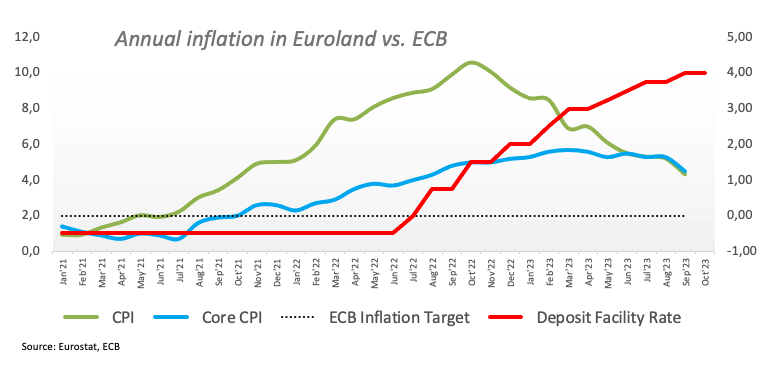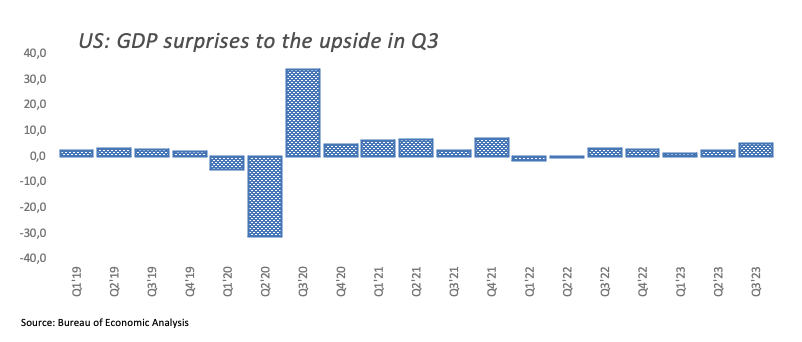- The Euro keeps the offered stance unchanged against the US Dollar.
- Flash US Q3 GDP Growth Rate surprises to the upside.
- EUR/USD meets some contention around 1.0520 so far.
- The ECB left its interest rates unchanged, as widely anticipated.
The Euro (EUR) manages to regain some composure vs. the US Dollar (USD), inducing EUR/USD to trim part of the initial drop to the 1.0520 region on Thursday.
On the other hand, the Greenback gives away some of the earlier advance to three-week highs around 106.90 when tracked by the USD Index (DXY), amist some corrective move in US yields over divergent maturities.
The offered bias prevails around the single currency after the European Central Bank (ECB) matched expectations and left its interest rates unchanged at its event on Thursday. At its statement, the ECB reiterated that inflation is seen higher for longer, at the time when the Council stated that current rate levels must be maintained for a sufficiently long period.
At her press conference and Q&A session, ECB President Christine Lagarde acknowledged that the region's economy is anticipated to remain undermined in the forthcoming months, while structural reforms have the potential to lessen inflationary pressures. She added, that risks to growth are disproportionately inclined downward and discussions pertaining to interest rate deductions are premature at this juncture. Lagarde also reiterated that long term monetary policy determinations will continue to rely on incoming data and suggested that elevating yields constitute a spillover effect that must be considered due to its capacity to drive inflation downward.
Still around monetary policy, there is a growing consensus among market participants that the Federal Reserve (Fed) will maintain its current stance of keeping interest rates unchanged at the meeting on November 1. This view has been reinforced by remarks made by Fed Chair Jerome Powell in his recent speech at the Economic Club of New York on October 19.
Data-wise, in the US, the flash Q3 GDP Growth Rate expanded 4.9% YoY, weekly Initial Jobless Claims increased by 210K in the week ended on October 21, Durable Goods Orders expanded markedly by 4.7% MoM in September and preliminary Goods Trade Balance see a deficit of $85.78B also in September.
Later in the session, Pending Home Sales will close the daily calendar.
Daily digest market movers: Euro gathers some traction post-ECB
- The EUR partly trims initial losses against the USD on Thursday.
- US and German yields trade amidst a broad-based decline.
- A 25 bps rate hike by the Fed remains on the table for December.
- No news at the ECB event on Thursday. Lagarde remained neutral
- Geopolitical concerns in the Middle East remain steady.
- The move above 150.00 in USD/JPY reignites intervention talk.
- Investors’ attention will also be on Lagarde’s press conference.
- US GDP figures are expected to show further resilience of the economy.
Technical Analysis: Euro's recovery remains capped by 1.0700
EUR/USD extends the bearish note to fresh weekly lows and shifts its attention to a potential visit to the 1.0500 neighbourhood.
If the selling trend continues, immediate support may be located near the October 13 low of 1.0495, followed by the 2023 low of 1.0448 seen on October 3 before hitting the round level of 1.0400. If this zone is crossed, the pair may continue to fall towards the lows of 1.0290 (November 30, 2022) and 1.0222 (November 21, 2022).
If bulls retake control, EUR/USD will find initial resistance around the Wednesday's top of 1.0694, which looks underpinned by the vicinity of the temporary 55-day Simple Moving Average (SMA). The breakout of this zone reveals the September 12 high of 1.0767, which precedes the significant 200-day SMA at 1.0813. Once this level is cleared, it might signal a further push towards the August 30 peaks of 1.0945, prior to the psychological milestone of 1.1000. If the rising trend continues, the August 10 peak of 1.1064 might be challenged, seconded by the July 27 high of 1.1149, and possibly even the 2023 top of 1.1275 seen on July 18.
As long as the EUR/USD continues below the 200-day SMA, the pair may face persistent negative pressure.
Euro FAQs
What is the Euro?
The Euro is the currency for the 20 European Union countries that belong to the Eurozone. It is the second most heavily traded currency in the world behind the US Dollar. In 2022, it accounted for 31% of all foreign exchange transactions, with an average daily turnover of over $2.2 trillion a day.
EUR/USD is the most heavily traded currency pair in the world, accounting for an estimated 30% off all transactions, followed by EUR/JPY (4%), EUR/GBP (3%) and EUR/AUD (2%).
What is the ECB and how does it impact the Euro?
The European Central Bank (ECB) in Frankfurt, Germany, is the reserve bank for the Eurozone. The ECB sets interest rates and manages monetary policy.
The ECB’s primary mandate is to maintain price stability, which means either controlling inflation or stimulating growth. Its primary tool is the raising or lowering of interest rates. Relatively high interest rates – or the expectation of higher rates – will usually benefit the Euro and vice versa.
The ECB Governing Council makes monetary policy decisions at meetings held eight times a year. Decisions are made by heads of the Eurozone national banks and six permanent members, including the President of the ECB, Christine Lagarde.
How does inflation data impact the value of the Euro?
Eurozone inflation data, measured by the Harmonized Index of Consumer Prices (HICP), is an important econometric for the Euro. If inflation rises more than expected, especially if above the ECB’s 2% target, it obliges the ECB to raise interest rates to bring it back under control.
Relatively high interest rates compared to its counterparts will usually benefit the Euro, as it makes the region more attractive as a place for global investors to park their money.
How does economic data influence the value of the Euro?
Data releases gauge the health of the economy and can impact on the Euro. Indicators such as GDP, Manufacturing and Services PMIs, employment, and consumer sentiment surveys can all influence the direction of the single currency.
A strong economy is good for the Euro. Not only does it attract more foreign investment but it may encourage the ECB to put up interest rates, which will directly strengthen the Euro. Otherwise, if economic data is weak, the Euro is likely to fall.
Economic data for the four largest economies in the euro area (Germany, France, Italy and Spain) are especially significant, as they account for 75% of the Eurozone’s economy.
How does the Trade Balance impact the Euro?
Another significant data release for the Euro is the Trade Balance. This indicator measures the difference between what a country earns from its exports and what it spends on imports over a given period.
If a country produces highly sought after exports then its currency will gain in value purely from the extra demand created from foreign buyers seeking to purchase these goods. Therefore, a positive net Trade Balance strengthens a currency and vice versa for a negative balance.
Information on these pages contains forward-looking statements that involve risks and uncertainties. Markets and instruments profiled on this page are for informational purposes only and should not in any way come across as a recommendation to buy or sell in these assets. You should do your own thorough research before making any investment decisions. FXStreet does not in any way guarantee that this information is free from mistakes, errors, or material misstatements. It also does not guarantee that this information is of a timely nature. Investing in Open Markets involves a great deal of risk, including the loss of all or a portion of your investment, as well as emotional distress. All risks, losses and costs associated with investing, including total loss of principal, are your responsibility. The views and opinions expressed in this article are those of the authors and do not necessarily reflect the official policy or position of FXStreet nor its advertisers. The author will not be held responsible for information that is found at the end of links posted on this page.
If not otherwise explicitly mentioned in the body of the article, at the time of writing, the author has no position in any stock mentioned in this article and no business relationship with any company mentioned. The author has not received compensation for writing this article, other than from FXStreet.
FXStreet and the author do not provide personalized recommendations. The author makes no representations as to the accuracy, completeness, or suitability of this information. FXStreet and the author will not be liable for any errors, omissions or any losses, injuries or damages arising from this information and its display or use. Errors and omissions excepted.
The author and FXStreet are not registered investment advisors and nothing in this article is intended to be investment advice.
Recommended content
Editors’ Picks
AUD/USD finally broke above 0.6700… will it last?

AUD/USD added to Tuesday’s advance and rose markedly in a context favourable to the risk-associated space following the sharp data-driven sell-off in the Greenback, while auspicious results from the domestic calendar also lent legs to AUD.
EUR/USD: Bullish outlook expected above the 200-day SMA

EUR/USD extended its multi-session recovery north of 1.0800 the figure following the persistent retracement in the US Dollar and against the backdrop of steady expectation ahead of the second round of French elections on July 7.
Gold reaches $2,360 on broad USD weakness

Gold gathers bullish momentum and trades at its highest level in nearly two weeks above $2,360. Following the disappointing ADP Employment Change and ISM Services PMI data from the US, the 10-year US yield declines sharply, helping XAU/USD extend its daily rally.
Ripple legal battle underway as on-chain metrics turn bullish, XRP eyes recovery to $0.50

Ripple made a comeback above $0.48 on Tuesday and hovers above that level in Wednesday’s European session. Ripple on-chain metrics such as transaction volume and Network Realized Profit/Loss (NPL) have turned bullish, supporting a recovery in the altcoin.
Disinflation in the United States: The scale of the sacrifice on the labour market

Since a 1977 act, the dual mandate of the Federal Reserve (Fed) has de jure entrusted it with the objectives of maximum employment and price stability (the latter being expected to favour the former in the long term).

